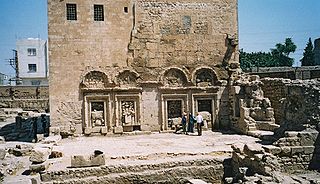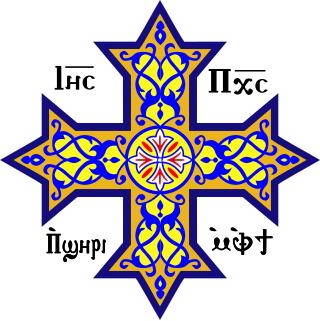Related Research Articles
Monasticism, also called monachism or monkhood, is a religious way of life in which one renounces worldly pursuits to devote oneself fully to spiritual work. Monastic life plays an important role in many Christian churches, especially in the Catholic, Orthodox and Anglican traditions as well as in other faiths such as Buddhism, Hinduism, and Jainism. In other religions, monasticism is generally criticized and not practiced, as in Islam and Zoroastrianism, or plays a marginal role, as in modern Judaism.
A monastery is a building or complex of buildings comprising the domestic quarters and workplaces of monastics, monks or nuns, whether living in communities or alone (hermits). A monastery generally includes a place reserved for prayer which may be a chapel, church, or temple, and may also serve as an oratory, or in the case of communities anything from a single building housing only one senior and two or three junior monks or nuns, to vast complexes and estates housing tens or hundreds. A monastery complex typically comprises a number of buildings which include a church, dormitory, cloister, refectory, library, balneary and infirmary, and outlying granges. Depending on the location, the monastic order and the occupation of its inhabitants, the complex may also include a wide range of buildings that facilitate self-sufficiency and service to the community. These may include a hospice, a school, and a range of agricultural and manufacturing buildings such as a barn, a forge, or a brewery.

Christian monasticism is a religious way of life of Christians who live ascetic and typically cloistered lives that are dedicated to Christian worship. It began to develop early in the history of the Christian Church, modeled upon scriptural examples and ideals, including those in the Old Testament. It has come to be regulated by religious rules and, in modern times, the Canon law of the respective Christian denominations that have forms of monastic living. Those living the monastic life are known by the generic terms monks (men) and nuns (women). The word monk originated from the Greek μοναχός, itself from μόνος meaning 'alone'.

The School of Nisibis was an educational establishment in Nisibis. It was an important spiritual centre of the early Church of the East, and like the Academy of Gondishapur, it is sometimes referred to as the world's first university. The school had three primary departments teaching: theology, philosophy and medicine. Its most famous teacher was Narsai, formerly head of the School of Edessa.
Babai the Great was an early church father of the Church of the East. He set several of the foundational pillars of the Church, revived the monastic movement, and formulated its Christology in a systematic way. He served as a monastic visitor and coadjutor with Mar Aba as unofficial heads of the Church of the East after Catholicos Gregory until 628 AD, leaving a legacy of strong discipline and deep religious Orthodoxy. He is revered in the modern Assyrian Church of the East and Ancient Church of the East.

Henana of Adiabene was a Christian theologian, and headmaster of the School of Nisibis, the main theological center of the Church of the East (571–610).

Mar Awgin or Awgen, also known as Awgin of Clysma or Saint Eugenios, was an Egyptian monk who, according to traditional accounts, introduced Christian monasticism to Syriac Christianity. These accounts, however, are all of late origin and often contain anachronisms. The historicity of Awgin is not certain.

Alphabetical list of Eastern Christianity-related articles on English Wikipedia
Abraham is a given name of Hebrew background, originating with the Biblical patriarch ; the father of the Abrahamic religions: Judaism, Christianity and Islam.

Eastern Christian monasticism is the life followed by monks and nuns of the Eastern Orthodox Church, Oriental Orthodoxy, the Church of the East and some Eastern Catholic Churches.
The degrees of Eastern Orthodox monasticism are the stages an Eastern Orthodox monk or nun passes through in their religious vocation.
Abraham of Farshut was an abbot and is a saint of the Coptic Church, and by extension all of the Oriental Orthodox Churches. His feast day in the calendar of saints of the Coptic Church is February 12.

Coptic monasticism was a movement in the Coptic Orthodox Church to create a holy, separate class of person from layman Christians.

The Patriarchal Province of Seleucia-Ctesiphon was an ecclesiastical province of the Church of the East, with see in Seleucia-Ctesiphon. It was attested between the fifth and thirteenth centuries. As its name entails, it was the province of the patriarch of the Church of the East. The province consisted of a number of dioceses in the region of Beth Aramaye, between Basra and Kirkuk, which were placed under the patriarch's direct supervision at the synod of Yahballaha I in 420.
The Metropolitanate of Merv was an East Syriac metropolitan province of the Church of the East, between the fifth and eleventh centuries, with several known suffragan dioceses.

Mount Izla, also Mountain of Nisibis or briefly in the 9th century Mount Kashyari, is a low mountain or ridge near Nisibis in what once a part of Assyria, then Sassanid Persian province of Asoristan, but is now southeastern Turkey, along the border with Syria. The ridge is the location of dozens of ancient monasteries which were built by the Assyrian Church of the East and Syriac Orthodox Church in the early centuries of Eastern Rite Christianity. In modern times, all of the monasteries are in ruins except for that of Mar Melke reconsecrated in the 1930s, Mor Yakub Monastery, founded in Dibek in 2012–2013, and the Monastery of Mor Augin which was refounded in 2008 after being abandoned in the 70's.
Diocese of Kashkar, sometimes called Kaskar, was the senior diocese in the Church of the East's Province of the Patriarch. Its see was in the city of Kashkar. The diocese is attested between the fourth and the twelfth centuries. The bishops of Kashkar had the privilege of guarding the patriarchal throne during the interregnum between the death of a patriarch and the appointment of his successor. As a result, they are often mentioned by name in the standard histories of the Nestorian patriarchs, so that a relatively full list of the bishops of the diocese has survived.
George of Izla was an East Syriac martyr, theologian and interpreter. He was mainly remembered for his role in a royal disputation which eventually led to his execution.
Dadishoʿ (528/9–604) was a monk and author of the Church of the East. He was the second abbot of the great monastery of Mount Izla after its founder, Abraham of Kashkar. He has sometimes been conflated with Dadishoʿ Qaṭraya, who lived a century later.
References
- Holweck, F. G., A Biographical Dictionary of the Saints. St. Louis, MO: B. Herder Book Co. 1924.